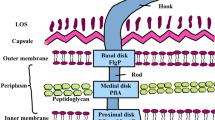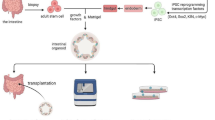Abstract
‘Candidatus Helicobacter suis’ is a spiral-shaped bacterium that colonizes the stomach of more than 60% of slaughter pigs. The role of ‘Candidatus Helicobacter suis’ in gastric disease of pigs is still unclear. Experimental studies in pigs are lacking because this bacterium is unculturable until now. An inoculation protocol using ‘Candidatus Helicobacter suis’ infected mouse stomach homogenate was used to reproduce the infection in pigs. Control animals were inoculated using negative mouse stomach homogenate. Pigs were inoculated three times with one-week intervals and euthanized 6 weeks post inoculation. Tissue samples were taken from different mucosal stomach regions to detect ‘Candidatus Helicobacter suis’ by PCR and urease test. Mucosal inflammation was evaluated on formalin-fixed tissue samples. Lesions in the pars oesophagea were scored macroscopically. Infection was succesful in all challenged animals, with the antrum and the fundus being predominantly positive. Infection was associated with infiltration of lymphocytes and plasma cells in the antral mucosa, evolving to follicular gastritis. No apparent inflammation of the fundic stomach region was detected in the infected animals. A clear link between ‘Candidatus Helicobacter suis’ and pars oesophageal lesions could not be found.
Similar content being viewed by others
Abbreviations
- BHI:
-
brain–heart infusion
- LYM:
-
lyophilization medium
- OD:
-
optical density
- PI:
-
Post inoculation
- SPF:
-
specific pathogen-free
References
Asghar, R.J. and Parsonnet, J., 2001. Helicobacter pylori and risk for gastric adenocarcinoma. Seminars in Gastrointestinal Disease, 12, 203–208
Barbosa, A.J.A., Silva, J.C.P., Nogueira, A.M.M.F., Paulino, E. and Miranda, C. R., 1995. Higher incidence of Gastrospirillum sp. in swine with gastric ulcer of the pars oesophagea. Veterinary Pathology, 32, 134–139
Choi, Y.K., Han, J.H. and Joo, H.S., 2001. Identification of novel Helicobacter species in pig stomachs by PCR and partial sequencing. Journal of Clinical Microbiology, 39, 3311–3315
Corthésy-Theulaz, I., Porta, N., Glauser, M., Saraga, E., Vaney, A.-C., Haas, R., Kraehenbulh, J.-P., Blum, A.L. and Michetti, P., 1995. Oral immunization with Helicobacter pylori urease B subunit as a treatment against Helicobacter infection in mice. Gastroenterology, 109, 115–121
Deen, J., 1993. The problem of gastroesophageal ulcers: a field description. In: Proceedings of the AD Leman Swine Conference, Minneapolis, MN, USA, 137–138
De Groote, D., van Doorn, L.-J., Ducatelle, R., Verschuuren, A., Haesebrouck, F., Quint, W.G.V., Jalava, K. and Vandamme, P., 1999. ‘Candidatus Helicobacter suis’, a gastric helicobacter from pigs and its phylogenetic relatedness to other gastrospirilla. International Journal of Systematic Bacteriology, 49, 1769–1777
De Groote, D., Ducatelle, R., van Doorn, L.J., Tilmant, K., Verschuuren, A. and Haesebrouck, F., 2000. Detection of “Candidatus Helicobacter suis” in gastric samples of pigs by PCR: comparison with other invasive diagnostic techniques. Journal of Clinical Microbiology, 38, 1131–1135
Friendship, R.M., 2003. Gastric ulcers. Pig News and Information, 24, 5N–48N
Grasso, G.M., Ripabelli, G., Sammarco, M.L, Ruberto, A. and Iannitto, G., 1996. Prevalence of Helicobacter-like organisms in porcine gastric mucosa: a study of swine slaughtered in Italy. Comparative Immunology, Microbiology and Infectious Diseases, 19, 213–217
Green, W.B., Eaton, K.A. and Krakowka, S., 1997. Porcine gastric mucosa associated lymphoïd tissue (MALT): stimulation by colonization with the gastric bacterial pathogen, Helicobacter pylori. Veterinary Immunology and Immunopathology, 56, 119–131
Hessing, J.J.C., Geudeke, M.J., Scheepens, C.J.M., Tielen, M.J.M., Schouten, W.G.P. and Wiepkema, P.R., 1992. Changes in the mucous membrane of the oesophageal part of the stomach—prevalence and relations to stress. Tijdschrift voor Diergeneeskunde, 117, 445–450
Koga, T., Shimada, Y., Sato, K., Takahashi, K., Kikuchi, I., Miura, T., Takenouchi, T., Narita, T. and Iwata, M., 2002. Experimental Helicobacter pylori gastric infection in miniature pigs. Journal of Medical Microbiology, 51, 238–246
Kontureck, P., Brzozowski, Ch.T., Konturek, S.J., Stachura, J., Karczewska, E., Pajdo, R., Ghiara P. and Hahn, E.G., 1999. Mouse model of Helicobacter pylori infection: studies on gastric function and ulcer healing. Alimentary Pharmacology and Therapeutics, 13, 333–346
Krakowka, S., Eaton, K.A., Rings, D.M. and Morgan, D.R., 1991. Gastritis induced by Helicobacter pylori in gnotobiotic piglets. Reviews in Infectious Disease, 13(Supplement 8), S681–685
Marshall, B.J. and Warren J.R., 1984. Unidentified curved bacilli in the stomach of patients with gastritis and peptic ulceration. Lancet 1, 1311–1315
Mendes, E.N., Queiroz, D.M.M., Rocha, G.A., Nogueira, A.M.M.F., Carvalho, A.C.T., Lage, A.P. and Barbosa, A.J.A., 1991. Histopathological study of porcine gastric mucosa with and without a spiral bacterium (“Gastrospirillum suis”). Journal of Medical Microbiology, 35, 345–348
Mendes, E.N., Queiroz, D.M.M., Moura, S.B. and Rocha, G., 1998. Mouse inoculation for the detection of non-cultivable gastric tightly spiralled bacteria. Brazilian Journal of Medical and Biological Research, 31, 373–376
O’Rourke, J.L., Solnick, J.V., Neilan, B.A., Seidel, K., Hayter, R., Hansen, L.M. and Lee, A., 2004. Description of “Candidatus Helicobacter heilmannii” based on DNA sequence analysis of 16S rRNA and urease genes. International Journal of Systematic and Evolutionary Microbiology, 54, 2203–2211
Papadogiannakis, N., Willén, R., Carlén, B., Sjöstedt, S., Waström, T. and Gad, A., 2000. Modes of adherence of Helicobacter pylori to gastric surface epithelium in gastroduodenal disease: a possible sequence of events leading to internalisation. Acta Pathologica, Microbiologica et Immunologica Scandicavica, 108, 439–447
Park, J.H., Lee, B.J, Lee, Y.S. and Park, J.H., 2000. Association of tightly spiraled bacterial infection and gastritis in pigs. Journal of Veterinary Medical Science, 62, 725–729
Philpott, D. J., Belaid, D., Troubadour, P., Thiberge, J.-M., Tankovic, J., Labigne, A. and Ferrero, R.L., 2002. Reduced activation of inflammatory responses in host cells by mouse-adapted Helicobacter pylori isolates. Cellular Microbiology, 4, 285–296
Queiroz, D.M.M., Rocha, G.A., Mendes, E.N., Lage, A.P., Carvalho, A.C.T. and Barbosa, A.J.A., 1990. A spiral microorganism in the stomach of pigs. Veterinary Microbiology, 24, 199–204
Queiroz, D.M.M., Rocha, G.A., Mendes, E.N., Mourra, S.B., Oliviera, A.M.R. and Miranda, D., 1996. Association between Helicobacter and gastric ulcer disease of the pars oesophagea in swine. Gastroenterology, 111, 19–27
Roosendaal, R., Vos, J.H., Roumen, T., Van Vugt, R., Cattoli, G., Bart, A., Klaasen, H.L.B.M., Kuipers, E.J., Vandenbroucke-Grauls, C.M.J.E. and Kusters, J.G., 2000. Slaugther pigs are commonly infected by closely related but distinct gastric ulcerative lesion-inducing gastrospirilla. Journal of Clinical Microbiology, 38, 2661–2664
Solnick, J.V., O’Rourke, J., Lee, A., Paster, B.J., Dewhirst, F.E. and Tompkins, L.S., 1993. An uncultured gastric spiral organism is a newly identified Helicobacter in humans. Journal of Infectious Disease, 168, 379–385
Trebesius, K., Alder, K., Vieth, M., Stolte, M. and Haas, R., 2001. Specific detection and prevalence of Helicobacter heilmannii-like organisms in the human gastric mucosa by fluorescent in situ hybridisation and partial 16S ribosomal DNA sequencing. Journal of Clinical Microbiology, 39, 1510–1516
Van den Bulck, K., Decostere, A., Baele, M., Driessen, A., Debongnie, J.C., Burette, A., Stolte, M., Ducatelle, R. and Haesebrouck F., 2005. Identification of non-Helicobacter pylori spiral organisms in gastric samples from humans, dogs and cats. Journal of Clinical Microbiology, 43, 2256–2260
Veldhuyzen van Zanten, S.J.O. and Sherman, P.M., 1994. Helicobacter pylori infection as a cause of gastritis, duodenal ulcer, gastric cancer and nonulcer dyspepsia: a systematic overview. Canadian Medical Association Journal, 150, 177–185
Author information
Authors and Affiliations
Corresponding author
Rights and permissions
About this article
Cite this article
Hellemans, A., Chiers, K., Decostere, A. et al. Experimental Infection of Pigs with ‘Candidatus Helicobacter suis’. Vet Res Commun 31, 385–395 (2007). https://doi.org/10.1007/s11259-006-3448-4
Accepted:
Published:
Issue Date:
DOI: https://doi.org/10.1007/s11259-006-3448-4




